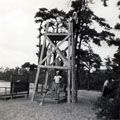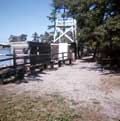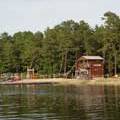The Waterfront Tower
Call it what you will: "The Waterfront" or "Aquatics" is arguably the most popular place at Summer Camp that doesn't sell snacks, and it's pretty easy to tell why. Even ignoring the beauty of Five Mile Pond and its white sandy shore, getting into the water (with your buddy, of course!) is simply the best way to cool off on a hot Cachalot summer's day. And for almost as long as there has been a Waterfront, we've had a Waterfront Tower for our lifeguards to keep a watchful eye on the proceedings.
Which Waterfront Tower you think of, however, will probably depend on when you went to summer camp: we've had three towers over the years, and the very first one looked quite a bit different in its first few years than it did in its last few.
The First Tower
Built in 1950, the first Waterfront Tower at Cachalot was one of the earliest buildings constructed in Camp, and certainly one of the simplest. Looking not too dissimilar from a classic X-trestle pioneering tower, it was an open structure with an observation platform at its top. While useful for spotting purposes, it didn't provide any shelter or storage on the waterfront:
It occurs to me that the lower half of your Tower, below observers platform, can be boarded in to make good storage place for oars, paddles, and other equipment. - 1951 Camp Inspection Report
Alan Novick, the Waterfront Director that year, makes a similar recommendation in his end-of-season report.
It is not immediately clear in what year the work was done to enclose the tower, but pictures provided to us show that, by the end of the 1950s, this recommendation had been followed through on and the lower portion of the tower was enclosed in white clapboards.
The first tower continued to be used in this configuration through the remainder of that decade and well into the 1960's, at least until the year of the Big Fire, 1964. While the Waterfront Tower did not suffer any significant damage in the fire, it had fallen into some disrepair, and with money available from the reconstruction capital campaign and a donation from Mr. and Mrs. Howard Young, a second tower was built in 1965.
The Andrew Jackson Tower
If you attended summer camp between 1966 and 1998, the Waterfront Tower you remember is the Andrew Jackson Memorial Tower. While not very different in construction from the tower that preceded it (the biggest difference was the use of rough-edged, dark-stained clapboards for the lower enclosure) this tower was very clearly dedicated to one Andrew Jackson, with monies provided by his granddaughter. A bronze plaque recording this was affixed to the tower itself. Unfortunately, over time, the memory of just who Andrew Jackson was faded from the Camp's collective memory. This left many campers familiar with the tower in later years to wonder why the tower would have been dedicated to our seventh President, and somewhat surprised that his granddaughter would have been around to donate a tower in his name.
In fact, it wasn't.
Mrs. Elizabeth (Chase) Young of North Dartmouth was the granddaughter of Andrew Jackson, a Portuguese whaler who had been born Andre Cabrara. He had been shanghaied from his childhood home in the Canary Islands, as a boy of 9 years old. After many years whaling, he eventually ended up first mate of the whaler Charles W. Morgan out of New Bedford, retiring from the sea to Marion in 1880. He had been urged to change his name by friends after arriving in America, and chose President Jackson's name after reading about and coming to admire him. Mr. Jackson passed away in 1903 [1].
The Jackson Tower remained in use for nearly 35 years, serving as storage area, observation deck, and the mounting spot for the Lost Bather Drill gong. After a number of years with very high water in Five Mile Pond, however, the bottom of the tower, including its corner supports, began to suffer rot, and once again the need for a new tower presented itself.
The Present Tower
The current Waterfront Tower (ostensibly named "The Falling Rock Waterfront Tower", although nothing currently on the tower indicates this) was completed in early 1999. The final funds to complete the tower came courtesy of a donation from a member of "The Falling Rock Patrol", Unlike the previous towers, the new tower was envisioned as being not only an observation tower and storage, but also as a residence for the Waterfront Director and perhaps members of the area staff.
The tower itself is a two-story structure, completely enclosed except for a second-story porch that serves as the observation deck and which provides a home for the "Lost Bather Drill" (LBD) Gong. The lower floor serves as program storage for the Waterfront, and the second story is equipped to sleep a small number of people (although it has not been used as a residence in recent summer camp seasons for a variety of reasons.) An external staircase leads up the eastern side of the structure to the second story. To help prevent the same rot conditions that damaged the Jackson Tower, and to increase the amount of usable beach, this tower is set back further from the edge of the water, and the beach was expanded in conjunction with its construction. Most recently, re-staining this tower was the Alumni Association's second major service project in camp, We hope it will continue to serve as our lookout point for swimmers and boaters for a long time to come!
[1] "Camp Tower to Be Named for Mariner" New Bedford Standard-Times, July 2, 1965.
All content copyright ©2004- by the Camp Cachalot Alumni Association, except where otherwise noted.
This page was last modified on Wed Feb 8th 2017.
Site look odd? Your browser may not be up to date. See the note on the main page.




